
The Oseberg ship is a well-preserved Viking ship discovered in a large burial mound at the Oseberg farm near Tønsberg in Vestfold county, Norway. This ship is commonly acknowledged to be among the finest artifacts to have survived from the Viking Age. The ship and some of its contents are displayed at the Viking Ship Museum at Bygdøy on the western side of Oslo, Norway.

Romerike is a traditional district located north-east of Oslo, in what is today south-eastern Norway. It consists of the Akershus municipalities Lillestrøm, Lørenskog, Nittedal, Rælingen and Aurskog-Høland in the southern end, and Ullensaker, Gjerdrum, Nannestad, Nes, Eidsvoll and Hurdal in the northern end .
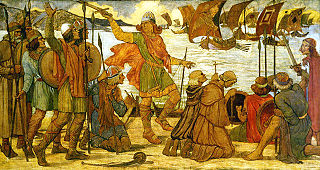
Knowledge about military technology of the Viking Age is based on relatively sparse archaeological finds, pictorial representations, and to some extent on the accounts in the Norse sagas and laws recorded in the 12th–14th century.

The Viking Ship Museum is located on the Bygdøy peninsula in Oslo, Norway. It will be temporarily closed from September 2021 until 2027.

The Tune ship (Tuneskipet) is a Viking ship exhibited in the Viking Ship Museum in Bygdøy, Oslo.
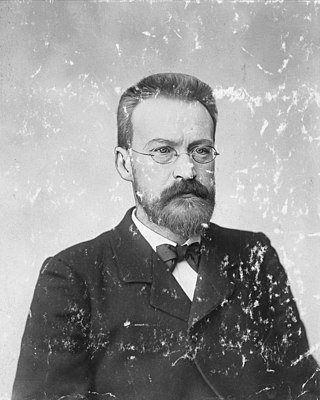
Gabriel Adolf Gustafson was a Swedish-Norwegian archaeologist. He was responsible for the excavation and conservation of the Oseberg Ship (Osebergfunnet).

Haakon Shetelig was a Norwegian archaeologist, historian and museum director. He was a pioneer in archaeology known for his study of art from the Viking Age in Norway. He is most frequently associated with his work on the Oseberg ship (Osebergfunnet) near Tønsberg, Norway.

Haugsbygd is a village in Ringerike municipality, northeast of the center of Hønefoss, in Buskerud, Norway.

The Coppergate Helmet is an eighth-century Anglo-Saxon helmet found in York, England. It was discovered in May 1982 during excavations for the Jorvik Viking Centre at the bottom of a pit that is thought to have once been a well.
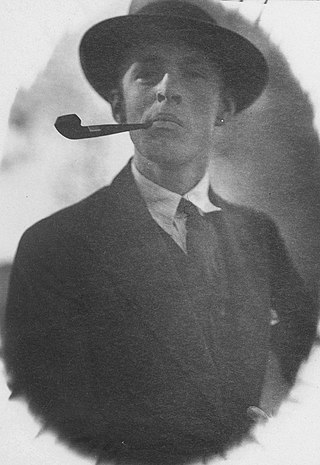
Sverre Marstrander was a Norwegian professor in archaeology.

The Sutton Hoo helmet is a decorated Anglo-Saxon helmet found during a 1939 excavation of the Sutton Hoo ship-burial. It was buried around the years c. 620–625 CE and is widely associated with an Anglo-Saxon leader, King Rædwald of East Anglia; its elaborate decoration may have given it a secondary function akin to a crown. The helmet was both a functional piece of armour and a decorative piece of metalwork. An iconic object from an archaeological find hailed as the "British Tutankhamen", it has become a symbol of the Early Middle Ages, "of Archaeology in general", and of England.

The Pioneer Helmet is an Anglo-Saxon boar-crested helmet from the late seventh century found in Wollaston, Northamptonshire, United Kingdom. It was discovered during a March 1997 excavation before the land was to be mined for gravel and was part of the grave of a young man. Other objects in the grave, such as a hanging bowl and a pattern welded sword, suggest that it was the burial mound of a high-status warrior.
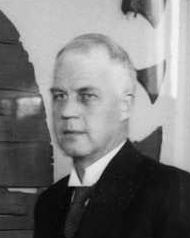
Sigurd Jebsen Grieg was a Norwegian museologist and archeologist. He was director of the Sandvig Collections at Maihaugen in Lillehammer. He is most associated with the excavation of Raknehaugen, a prehistoric burial barrow located at Ullensaker in Akershus, Norway.

The Shorwell helmet is an Anglo-Saxon helmet from the early to mid-sixth century AD found near Shorwell on the Isle of Wight in southern England. It was one of the grave goods of a high-status Anglo-Saxon warrior, and was found with other objects such as a pattern-welded sword and hanging bowl. One of only six known Anglo-Saxon helmets, alongside those found at Benty Grange (1848), Sutton Hoo (1939), Coppergate (1982), Wollaston (1997), and Staffordshire (2009), it is the sole example to derive from the continental Frankish style rather than the contemporaneous Northern "crested helmets" used in England and Scandinavia.
Dominic Tweddle,, is an English archaeologist specialising in Anglo-Saxon studies and the director general of the National Museum of the Royal Navy. Previously he spent time as a research assistant at the British Museum and as the assistant director of the York Archaeological Trust, where he helped develop the Jorvik Viking Centre. He is also an honorary professor at the UCL Institute of Archaeology and the University of Portsmouth.

The Tjele helmet fragment is a Viking Age fragment of iron and bronze, originally comprising the eyebrows and noseguard of a helmet. It was discovered in 1850 with a large assortment of smith's tools in Denmark, and though the find was sent to the National Museum of Denmark, for 134 years the fragment was mistaken for a saddle mount. In 1984 it was properly identified by an assistant keeper at the museum as the remainder of one of only five known helmets from the Viking era.

The Lokrume helmet fragment is a decorated eyebrow piece from a Viking Age helmet. It is made of iron, the surface of which is covered with silver and features an interlace pattern in niello or wire. Discovered in Lokrume, a small settlement on the Swedish island of Gotland, the fragment was first described in print in 1907 and is in the collection of the Gotland Museum.

The Gokstad Mound is a large burial mound at Gokstad Farm in Sandefjord in Vestfold County, Norway. It is also known as the King's Mound (Kongshaugen) and is where the 9th century Gokstad Ship was found.
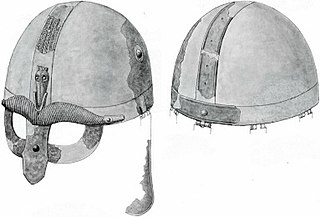
The Broe helmet is a decorated iron helmet from around the Vendel Period. Discovered around 1904 in a cremation grave in Broe, a farm on the Swedish island Gotland, it was located alongside other items including fragments of shields, weapons, bridles, and game pieces. Due to its extremely fragmented condition, only an incomplete reconstruction of the helmet is possible, but it appears to have been an example of the "crested helmets" that flourished in England and Scandinavia from the sixth through eleventh centuries.

The Yarm helmet is a circa 10th-century Viking Age Anglo-Scandinavian helmet that was found in Yarm in the North Riding of Yorkshire, England. It is the first relatively complete Anglo-Scandinavian helmet found in Britain and only the second relatively complete/intact Viking helmet discovered in north-west Europe.



















